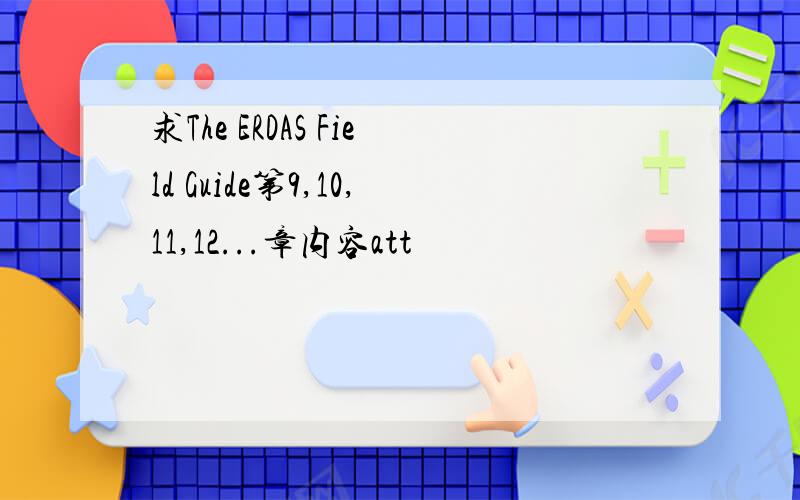求The ERDAS Field Guide第9,10,11,12...章内容att
来源:学生作业帮助网 编辑:作业帮 时间:2024/11/24 13:20:48

求The ERDAS Field Guide第9,10,11,12...章内容att
求The ERDAS Field Guide第9,10,11,12...章内容
att
求The ERDAS Field Guide第9,10,11,12...章内容att
九..This chapter tells you about the advanced radar processing packages that ERDAS IMAGINE has to offer. The following sections go into detail about the geometry and functionality of those modules of the IMAGINE Radar Mapping Suite.
十一Terrain analysis involves the processing and graphic simulation of elevation data. Terrain analysis software functions usually work with topographic data (also called terrain data or elevation data), in which an elevation (or Z value) is recorded at each X,Y location. However, terrain analysis functions are not restricted to topographic data. Any series of values, such as population densities, ground water pressure values, magnetic and gravity measurements, and chemical concentrations, may be used.
Topographic data are essential for studies of trafficability, route design, nonpoint source pollution, intervisibility, siting of recreation areas, etc. Especially useful are products derived from topographic data. These include:
• slope images
• aspect images
• shaded relief images
Topographic data and its derivative products have many applications, including:
Terrain data are often used as a component in complex GIS modeling or classification routines.
十二Today, a GIS is a unique system designed to input, store, retrieve, manipulate, and analyze layers of geographic data to produce interpretable information. A GIS should also be able to create reports and maps.
The central purpose of a GIS is to turn geographic data into useful information—the answers to real-life questions.
Information vs. Data
Information, as opposed to data, is independently meaningful.
Data Input
(注意ERDAS偏向描述栅格GIS)
Acquiring the appropriate data for a project involves creating a database of layers that encompasses the study area.
Analysis
ERDAS IMAGINE Analysis Tools
Spatial Modeler Language
Model Maker
Image Interpreter
Customizing ERDAS IMAGINE Tools
Analysis Procedures
Once the database (layers and attribute data) is assembled, the layers can be analyzed and new information extracted. Some information can be extracted simply by looking at the layers and visually comparing them to other layers. However, new information can be retrieved by combining and comparing layers using the following procedures(下面的分析工具).
Using an Area of Interest
You can also select a particular AOI for analysis.
Proximity Analysis
(类似Buffer的邻近性分析)
Proximity analysis determines which pixels of a layer are located at specified distances from pixels in a certain class or classes.
In further analysis, it may be beneficial to weight other factors, based on whether they fall inside or outside the buffer zone.
(Figure 12-4)
Contiguity Analysis (连接区分析)
(Contiguity 有一解释:A continuous mass or series. 一片连绵不断的一大片或一个系列)
Contiguity analysis is concerned with the ways in which pixels of a class are grouped together. Groups of contiguous pixels in the same class, called raster regions, or clumps, can be identified by their sizes and manipulated. One application of this tool would be an analysis for locating helicopter landing zones that require at least 250 contiguous pixels at 10-meter resolution.
Contiguity analysis can be used to:
1) divide a large class into separate raster regions, or
2) eliminate raster regions that are too small to be considered for an application. they can be filtered out according to their sizes.
Filtering Clumps
(Figure 12-5, 原图黄色未能复印出来,必须看原图.)
Neighborhood Analysis (利用活动窗口做像元邻域分析)
With a process similar to the convolution filtering of continuous raster layers, thematic raster layers can also be filtered. The GIS filtering process is sometimes referred to as scanning. Neighborhood analysis is based on local or neighborhood characteristics of the data.
Defining Scan Area
You may define the area of the file to be scanned. The scanning window moves only through this area as the analysis is performed.
Neighborhood analysis creates a new thematic layer. There are several types of analysis that can be performed upon each window of pixels, as described below:
• Boundary
• Density
• Diversity
• Majority
• • •
(Figure 12-7)
Recoding
Class values can be recoded to new values. Recoding involves the assignment of new values to one or more classes. Recoding is used to:
• reduce the number of classes
• combine classes
• assign different class values to existing classes
(Table 12-1及其上面两行说明)
下面三种叠合分析
Overlaying
Thematic data layers can be overlaid to create a composite layer. The output layer contains either the minimum or the maximum class values of the input layers.
(Figure 12-8)
Indexing
Thematic layers can be indexed (added) to create a composite layer. The output layer contains the sums of the input layer values.
(Figure 12-9及其图后一段说明)
Matrix Analysis
(为两层类别的每一个配对指定一输出类,上两个Overlay分析可以看作此分析的特例)
Matrix analysis produces a thematic layer that contains a separate class for every coincidence of classes in two layers. The output is best described with a matrix diagram.
(text P398上的图)
Modeling
(调用各种可能手段建立分析模型,参照Figure 12-10理解)
Modeling is a powerful and flexible analysis tool. Modeling is the process of creating new layers from combining or operating upon existing layers.
十四Maps and mapping are the subject of the art and science known as cartography—creating twodimensional representations of our three-dimensional Earth.
This chapter defines some basic cartographic terms and explains how maps are created within the ERDAS IMAGINE environment.